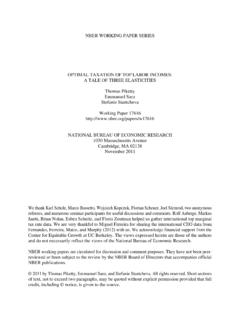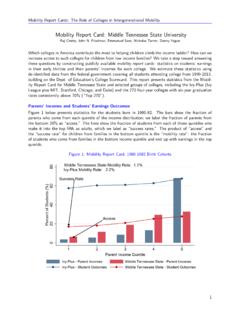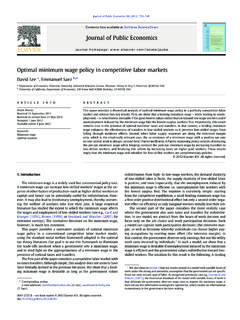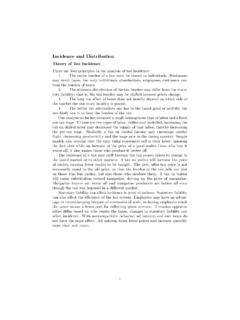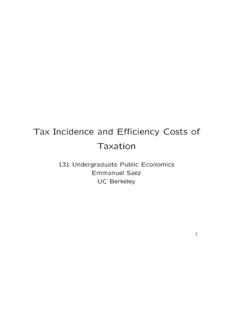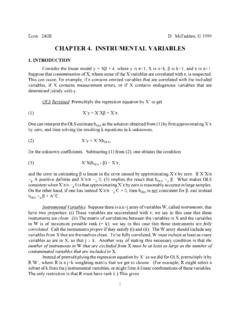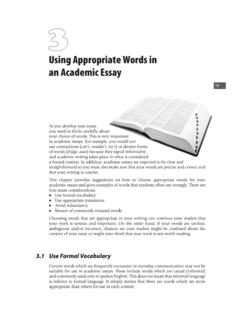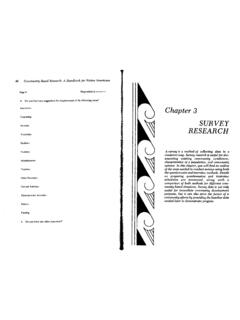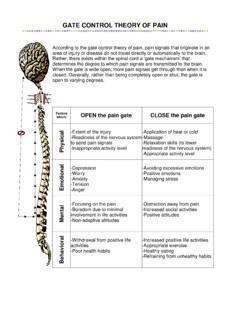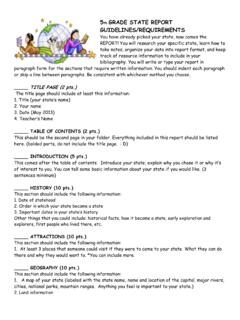Transcription of Discrete Choice Methods with Simulation
1 Discrete Choice Methods withSimulationKenneth TrainUniversity of California, BerkeleyNational Economic Research AssociatesVersion dated March 8, 2002 Publisher: Cambridge University PressScheduled publication date: Autumn contact me with any corrections, comments,and suggestions, at McFaddenandin memory ofKenneth Train, copy is made available for use by individuals for their personalresearch and study. Permission is not granted to use any part of thiswork for any other purpose whatsoever without the written consent ofCambridge University Motivation .. Choice Probabilities and Integration .. Topics not covered.
2 Acouplenotes .. 12I Behavioral Models132 Derivation of Choice probabilities .. Specificmodels .. Only differences in utility matter .. The overall scale of utility is Sampleenumeration .. Forecasting .. 393 Choice probabilities .. Thescaleparameter .. Tastevariation .. Substitution patterns .. Paneldata .. Non-linear representative ConsumerSurplus .. DerivativesandElasticities .. Estimation .. Exogenoussample .. Choice -basedsamples .. GoodnessofFitandHypothesisTesting .. Goodnessoffit .. Hypothesistesting .. Case Study.
3 Derivation of Logit Probabilities .. Substitution patterns .. Choice probabilities .. Estimation .. Equivalenceofnestedlogitformulas .. Three-Level Nested Logit .. OverlappingNests .. Generalizednestedlogit .. HeteroskedasticLogit .. TheGEVfamily ..1065 Choice probabilities .. Identification .. Tastevariation .. Substitution patterns/non-IIA .. Simulation of the Choice probabilities .. Accept-rejectsimulator .. Mixed Choice probabilities .. Randomcoefficients .. Substitution patterns .. Approximation to any random utility model .. Case Study.
4 1687 Variations on a RankedData .. Standardandmixedlogit .. Ordered Responses .. Multiple ordered responses .. MixedNestedLogit .. MixedProbit .. Dynamicoptimization .. Two-periods, no uncertainty about future Multipleperiods .. Uncertainty about future impacts ..203II Estimation2098 Numerical Motivation .. Algorithms .. DFPandBFGS .. Convergencecriterion .. VarianceoftheEstimates .. InformationIdentity ..2299 Drawing from Transformationsofstandardnormal .. Inverse cumulative for univariate densities .. Truncatedunivariatedensities .. Choleski transformation for multivariate normals Accept-reject for truncated multivariate densities Metropolis-Hastings Antithetics.
5 Systematicsampling .. Simulation -Assisted .. Methodofsimulatedmoments:MSM .. Maximumsimulatedlikelihood .. Methodofsimulatedmoments .. Methodofsimulatedscores .. Individual-Level Derivation of conditional distribution .. Implications of estimation of .. Monte Carlo Average conditional distribution .. Case Study .. Bayesian Overview of Bayesian Bayesian properties of .. Classical properties of : The Bernstein-von .. Result A: Unknown mean, known variance .. Result B: Unknown variance, known mean .. Unknownmeanandvariance .. Case Study: Choice of energy Fixedcoefficientsforsomevariables.
6 Lognormals .. Triangulars ..355xCONTENTSC hapter MotivationWhen I wrote my first book,Qualitative Choice Analysis, in the mid1980 s, the field had reached a critical juncture. The break-throughconcepts that defined the field had been made. The basic models mainly logit and nested logit had been introduced, and the sta-tistical and economic properties of these models had been had proven successful in many different areas, includingtransportation, energy, housing, and marketing to name only a field is at a similar juncture today for a new generation of pro-cedures. The first-generation models contained important limitationsthat inhibited their applicability and realism.
7 These limitations werewell recognized at the time, but ways to overcome them had not yetbeen discovered. Over the past twenty years, tremendous progress hasbeen made, leading to what can only be called a sea-change in theapproach and Methods of Choice analysis. The early models have nowbeen supplemented by a variety of more powerful and more flexiblemethods. The new concepts have arisen gradually, with researchersbuilding on the work of others. However, in a sense, the change hasbeen more like a quantum leap than a gradual progression. The waysthat researchers think about, specify, and estimate their models haschanged. Importantly, a kind of consensus, or understanding, seems tohave emerged about the new methodology.
8 Among researchers workingin the field, a definite sense of purpose and progress purpose in writing this new book is to bring these ideas to-gether, in a form that exemplifies the unity of approach that I feel12 CHAPTER 1. INTRODUCTIONhas emerged, and in a format that makes the Methods accessible toa wide audience. The advances have mostly centered on , Simulation is the researcher s response to the inability ofcomputers to perform integration. Stated more precisely, simulationprovides a numerical approximation to integrals, with different meth-ods offering different properties and being applicable to different kindsof allows estimation of otherwise intractable models.
9 Prac-tically any model can be estimated by some form of Simulation . Theresearcher is therefore freed from previous constraints on model spec-ification constraints that reflected mathematical convenience ratherthan the economic reality of the situation. This new flexibility is atremendous boon to research. It allows more realistic representationof the hugely varied Choice situations that arise in the world. It en-ables the researcher to obtain more information from any given datasetand, in many cases, allows previously unapproachable issues to be flexibility places a new burden on the researcher. First, themethods themselves are more complicated than earlier procedures andutilize many concepts and procedures that are not covered in stan-dard econometrics courses.
10 Understanding the various techniques their advantages and limitations, and the relations among them isimportant when choosing the appropriate method in any particularapplication and for developing new Methods when none of the existingmodels seems right. The purpose of this book is to assist readers alongthis , to implement a new method, or a variant on an old method,the researcher needs to be able to program the procedure into com-puter software. This means that the researcher will often need toknow how maximum likelihood and other estimation Methods workfrom a computational perspective, how to code specific models, andhow to take existing code and change it to represent variations inbehavior.

